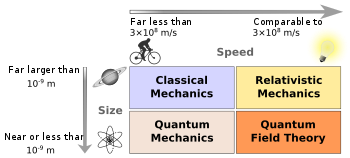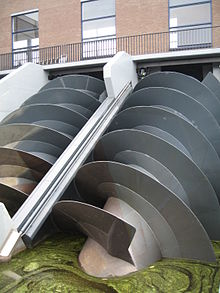Physics: Difference between revisions
→History: elaborated |
|||
| Line 62: | Line 62: | ||
{{main|History of physics}} |
{{main|History of physics}} |
||
[[Image:Francesco Hayez 001.jpg|thumb|150px|right|[[Aristotle]]]] |
[[Image:Francesco Hayez 001.jpg|thumb|150px|right|[[Aristotle]]]] |
||
Since antiquity, people have tried to understand the behavior of the natural world. One great mystery was the predictable behavior of celestial objects such as the [[Sun]] and the [[Moon]]. Several theories were proposed, the majority of which were disproved. Early physical theories were largely couched in philosophical terms, and never verified by systematic experimental testing as is popular today. Many of the commonly accepted works of [[Ptolemy]] and [[Physics (Aristotle)|Aristotle]] are not always found to match everyday observations. Even so, [[Indian philosophy|Indian philosophers]] and [[Indian |
Since antiquity, people have tried to understand the behavior of the natural world. One great mystery was the predictable behavior of celestial objects such as the [[Sun]] and the [[Moon]]. Several theories were proposed, the majority of which were disproved. Early physical theories were largely couched in philosophical terms, and never verified by systematic experimental testing as is popular today. Many of the commonly accepted works of [[Ptolemy]] and [[Physics (Aristotle)|Aristotle]] are not always found to match everyday observations. Even so, [[Chinese philosophy|Chinese]] and [[Indian philosophy|Indian philosophers]] and [[Indian astronomy|astronomers]] gave many correct descriptions in [[atomism]] and [[astronomy]], and the [[Ancient Greece|Greek]] thinker [[Archimedes]] derived many correct quantitative descriptions of [[mechanics]] and [[hydrostatics]]. A more [[experimental physics]] began taking shape among [[Physics in medieval Islam|medieval Muslim physicists]], while modern physics largely took shape among [[early modern Europe]]an physicists. |
||
==Branches of physics== |
==Branches of physics== |
||
Revision as of 21:21, 13 June 2009

Physics (Greek: physis – φύσις meaning "nature") a natural science, is the study of matter[1] and its motion through spacetime and all that derives from these, such as energy and force.[2] More broadly, it is the general analysis of nature, conducted in order to understand how the world and universe behave.[3][4]
Physics is one of the oldest academic disciplines, perhaps the oldest through its inclusion of astronomy.[5] Over the last two millennia, physics had been considered synonymous with philosophy, chemistry, and certain branches of mathematics and biology, but during the Scientific Revolution in the 16th century, it emerged to become a unique modern science in its own right.[6] However, in some subject areas such as in mathematical physics and quantum chemistry, the boundaries of physics remain difficult to distinguish.
Physics is both significant and influential, in part because advances in its understanding have often translated into new technologies, but also because new ideas in physics often resonate with the other sciences, mathematics and philosophy. For example, advances in the understanding of electromagnetism led directly to the development of new products which have dramatically transformed modern-day society (e.g., television, computers, and domestic appliances); advances in thermodynamics led to the development of motorized transport; and advances in mechanics inspired the development of calculus.
| Physics |
|---|
| History of physics |
Scope and aims

Physics covers a wide range of phenomena, from the smallest sub-atomic particles, to the largest galaxies. Included in this are the very most basic objects from which all other things are composed, and therefore physics is sometimes said to be the "fundamental science".[7]
Physics aims to describe the various phenomena that occur in nature in terms of simpler phenomena. Thus, physics aims to both connect the things we see around us to root causes, and then to try to connect these causes together in the hope of finding an ultimate reason for why nature is as it is. For example, the ancient Chinese observed that certain rocks (lodestone) were attracted to one another by some invisible force. This effect was later called magnetism, and was first rigorously studied in the 17th century. A little earlier than the Chinese, the ancient Greeks knew of other objects such as amber, that when rubbed with fur would cause a similar invisible attraction between the two. This was also first studied rigorously in the 17th century, and came to be called electricity. Thus, physics had come to understand two observations of nature in terms of some root cause (electricity and magnetism). However, further work in the 19th century revealed that these two forces were just two different aspects of one force – electromagnetism. This process of "unifying" forces continues today (see section Current research for more information).
The scientific method
Physics uses the scientific method to test the validity of a physical theory, using a methodical approach to compare the implications of the theory in question with the associated conclusions drawn from experiments and observations conducted to test it. Experiments and observations are to be collected and matched with the predictions and hypotheses made by a theory, thus aiding in the determination or the validity/invalidity of the theory.
Theories which are very well supported by data and have never failed any competent empirical test are often called scientific laws, or natural laws. Of course, all theories, including those called scientific laws, can always be replaced by more accurate, generalized statements if a disagreement of theory with observed data is ever found.[8]
Theory and experiment


The culture of physics has a higher degree of separation between theory and experiment than many other sciences. Since the twentieth century, most individual physicists have specialized in either theoretical physics or experimental physics. In contrast, almost all the successful theorists in biology and chemistry (e.g. American quantum chemist and biochemist Linus Pauling) have also been experimentalists, although this is changing as of late.
Theorists seek to develop mathematical models that both agree with existing experiments and successfully predict future results, while experimentalists devise and perform experiments to test theoretical predictions and explore new phenomena. Although theory and experiment are developed separately, they are strongly dependent upon each other. Progress in physics frequently comes about when experimentalists make a discovery that existing theories cannot explain, or when new theories generate experimentally testable predictions, which inspire new experiments. In the absence of experiment, theoretical research can go in the wrong direction; this is one of the criticisms that has been leveled against M-theory, a popular theory in high-energy physics for which no practical experimental test has ever been devised. It is also worth noting there are some physicists who work at the interplay of theory and experiment who are called phenomenologists. Phenomenologists look at the complex phenomena observed in experiment and work to relate them to fundamental theory.
Theoretical physics is closely related to mathematics, which provides the language of physical theories, and large areas of mathematics, such as calculus, have been invented specifically to solve problems in physics. Theorists may also rely on numerical analysis and computer simulations. The fields of mathematical and computational physics are active areas of research. Theoretical physics has historically rested on philosophy and metaphysics; electromagnetism was unified this way.[9] Beyond the known universe, the field of theoretical physics also deals with hypothetical issues,[10] such as parallel universes, a multiverse, and higher dimensions. Physicists speculate on these possibilities, and from them, hypothesize theories.
Experimental physics informs, and is informed by, engineering and technology. Experimental physicists involved in basic research design and perform experiments with equipment such as particle accelerators and lasers, whereas those involved in applied research often work in industry, developing technologies such as magnetic resonance imaging (MRI) and transistors. Feynman has noted that experimentalists may seek areas which are not well explored by theorists.[citation needed]
Relation to mathematics and the other sciences
In the Assayer (1622), Galileo noted that mathematics is the language in which Nature expresses its laws.[11] Most of the experimental results in physics are numerical measurements and theories in physics use mathematics to give numerical results to match these measurements. Physics relies on mathematics to provide the logical framework in which physical laws can be precisely formulated and predictions quantified. Whenever analytic solutions of equations are not feasible, numerical analysis and simulations can be utilized. Thus, scientific computation is an integral part of physics, and the field of computational physics is an active area of research.
A key difference between physics and mathematics is that since physics is ultimately concerned with descriptions of the material world, it tests its theories by comparing the predictions of its theories with data procured from observations and experimentation, whereas mathematics is concerned with abstract patterns, not limited by those observed in the real world. The distinction, however, is not always clear-cut. There is a large area of research intermediate between physics and mathematics, known as mathematical physics.
Physics is also intimately related to many other sciences, as well as applied fields like engineering and medicine. The principles of physics find applications throughout the other natural sciences as some phenomena studied in physics, such as the conservation of energy, are common to all material systems. Other phenomena, such as superconductivity, stem from these laws, but are not laws themselves because they only appear in some systems. Physics is often said to be the "fundamental science" (chemistry is sometimes included), because each of the other disciplines (biology, chemistry, geology, material science, engineering, medicine etc.) deals with particular types of material systems that obey the laws of physics.[7] For example, chemistry is the science of collections of matter (such as gases and liquids formed of atoms and molecules) and the processes known as chemical reactions that result in the change of chemical substances. The structure, reactivity, and properties of a chemical compound are determined by the properties of the underlying molecules, which can be described by areas of physics such as quantum mechanics (called in this case quantum chemistry), thermodynamics, and electromagnetism.
Philosophical implications
Physics in many ways stemmed from ancient Greek philosophy. From Thales' first attempt to characterize matter, to Democritus' deduction that matter ought to reduce to an invariant state, the Ptolemaic astronomy of a crystalline firmament, and Aristotle's book Physics, different Greek philosophers advanced their own theories of nature. Well into the 18th century, physics was known as "Natural philosophy".
By the 19th century physics was realized as a positive science and a distinct discipline separate from philosophy and the other sciences. Physics, as with the rest of science, relies on philosophy of science to give an adequate description of the scientific method.[12] The scientific method employs a priori reasoning as well as a posteriori reasoning and the use of Bayesian inference to measure the validity of a given theory.[13]
Truth is ever to be found in the simplicity, and not in the multiplicity and confusion of things.
The development of physics has answered many questions of early philosophers, but has also raised new questions. Study of the philosophical issues surrounding physics, the philosophy of physics, involves issues such as the nature of space and time, determinism, and metaphysical outlooks such as empiricism, naturalism and realism.[14]
Many physicists have written about the philosophical implications of their work, for instance Laplace, who championed causal determinism,[15] and Erwin Schrödinger, who wrote on Quantum Mechanics.[16] The mathematical physicist Roger Penrose has been called a Platonist by Stephen Hawking,[17] a view Penrose discusses in his book, The Road to Reality.[18] Hawking refers to himself as an "unashamed reductionist" and takes issue with Penrose's views.[19]
History

Since antiquity, people have tried to understand the behavior of the natural world. One great mystery was the predictable behavior of celestial objects such as the Sun and the Moon. Several theories were proposed, the majority of which were disproved. Early physical theories were largely couched in philosophical terms, and never verified by systematic experimental testing as is popular today. Many of the commonly accepted works of Ptolemy and Aristotle are not always found to match everyday observations. Even so, Chinese and Indian philosophers and astronomers gave many correct descriptions in atomism and astronomy, and the Greek thinker Archimedes derived many correct quantitative descriptions of mechanics and hydrostatics. A more experimental physics began taking shape among medieval Muslim physicists, while modern physics largely took shape among early modern European physicists.
Branches of physics

While physics deals with a wide variety of systems, there are certain theories that are used by all physicists. Each of these theories were experimentally tested numerous times and found correct as an approximation of Nature (within a certain domain of validity). For instance, the theory of classical mechanics accurately describes the motion of objects, provided they are much larger than atoms and moving at much less than the speed of light. These theories continue to be areas of active research; for instance, a remarkable aspect of classical mechanics known as chaos was discovered in the 20th century, three centuries after the original formulation of classical mechanics by Isaac Newton (1642–1727). These "central theories" are important tools for research into more specialized topics, and any physicist, regardless of his or her specialization, is expected to be literate in them.
Research fields
Contemporary research in physics can be broadly divided into condensed matter physics; atomic, molecular, and optical physics; particle physics; astrophysics; geophysics and biophysics. Some physics departments also support research in Physics education. Since the twentieth century, the individual fields of physics have become increasingly specialized, and today most physicists work in a single field for their entire careers. "Universalists" such as Albert Einstein (1879–1955) and Lev Landau (1908–1968), who worked in multiple fields of physics, are now very rare.[20]
Condensed matter

Condensed matter physics is the field of physics that deals with the macroscopic physical properties of matter. In particular, it is concerned with the "condensed" phases that appear whenever the number of constituents in a system is extremely large and the interactions between the constituents are strong. The most familiar examples of condensed phases are solids and liquids, which arise from the bonding and electromagnetic force between atoms. More exotic condensed phases include the superfluid and the Bose-Einstein condensate found in certain atomic systems at very low temperature, the superconducting phase exhibited by conduction electrons in certain materials, and the ferromagnetic and antiferromagnetic phases of spins on atomic lattices.
Condensed matter physics is by far the largest field of contemporary physics. By one estimate, one third of all American physicists identify themselves as condensed matter physicists.[citation needed] Historically, condensed matter physics grew out of solid-state physics, which is now considered one of its main subfields. The term condensed matter physics was apparently coined by Philip Anderson when he renamed his research group — previously solid-state theory — in 1967. In 1978, the Division of Solid State Physics at the American Physical Society was renamed as the Division of Condensed Matter Physics.[21] Condensed matter physics has a large overlap with chemistry, materials science, nanotechnology and engineering.
Atomic, molecular, and optical physics
Atomic, molecular, and optical physics (AMO) is the study of matter-matter and light-matter interactions on the scale of single atoms or structures containing a few atoms. The three areas are grouped together because of their interrelationships, the similarity of methods used, and the commonality of the energy scales that are relevant. All three areas include both classical and quantum treatments; they can treat their subject from a microscopic view (in contrast to a macroscopic view).
Atomic physics studies the electron shells of atoms. Current research focuses on activities in quantum control, cooling and trapping of atoms and ions, low-temperature collision dynamics, the collective behavior of atoms in weakly interacting gases (Bose-Einstein Condensates and dilute Fermi degenerate systems), precision measurements of fundamental constants, and the effects of electron correlation on structure and dynamics. Atomic physics is influenced by the nucleus (see, e.g., hyperfine splitting), but intra-nuclear phenomenon such as fission and fusion are considered part of high energy physics.
Molecular physics focuses on multi-atomic structures and their internal and external interactions with matter and light. Optical physics is distinct from optics in that it tends to focus not on the control of classical light fields by macroscopic objects, but on the fundamental properties of optical fields and their interactions with matter in the microscopic realm.
High energy/particle physics

Particle physics is the study of the elementary constituents of matter and energy, and the interactions between them. It may also be called "high energy physics", because many elementary particles do not occur naturally, but are created only during high energy collisions of other particles, as can be detected in particle accelerators.
Currently, the interactions of elementary particles are described by the Standard Model. The model accounts for the 12 known particles of matter that interact via the strong, weak, and electromagnetic fundamental forces. Dynamics are described in terms of matter particles exchanging messenger particles that carry the forces. These messenger particles are known as gluons; W− and W+ and Z bosons; and the photons, respectively. The Standard Model also predicts a particle known as the Higgs boson, the existence of which has not yet been verified.
Astrophysics

Astrophysics and astronomy are the application of the theories and methods of physics to the study of stellar structure, stellar evolution, the origin of the solar system, and related problems of cosmology. Because astrophysics is a broad subject, astrophysicists typically apply many disciplines of physics, including mechanics, electromagnetism, statistical mechanics, thermodynamics, quantum mechanics, relativity, nuclear and particle physics, and atomic and molecular physics.
The discovery by Karl Jansky in 1931 that radio signals were emitted by celestial bodies initiated the science of radio astronomy. Most recently, the frontiers of astronomy have been expanded by space exploration. Perturbations and interference from the earth’s atmosphere make space-based observations necessary for infrared, ultraviolet, gamma-ray, and X-ray astronomy.
Physical cosmology is the study of the formation and evolution of the universe on its largest scales. Albert Einstein’s theory of relativity plays a central role in all modern cosmological theories. In the early 20th century, Hubble's discovery that the universe was expanding, as shown by the Hubble diagram, prompted rival explanations known as the steady state universe and the Big Bang. The Big Bang was confirmed by the success of Big Bang nucleosynthesis and the discovery of the cosmic microwave background in 1964. The Big Bang model rests on two theoretical pillars: Albert Einstein's general relativity and the cosmological principle. Cosmologists have recently established a precise model of the evolution of the universe, which includes cosmic inflation, dark energy and dark matter.
Application and influence

Applied physics is a general term for physics research which is intended for a particular use. An applied physics curriculum usually contains a few classes in an applied discipline, like geology or electrical engineering. It usually differs from engineering in that an applied physicist may not be designing something in particular, but rather is using physics or conducting physics research with the aim of developing new technologies or solving a problem. The approach is similar to that of applied mathematics. Applied physicists can also be interested in the use of physics for scientific research. For instance, people working on accelerator physics might seek to build better particle detectors for research in theoretical physics.
Physics is used heavily in engineering. For example, Statics, a subfield of mechanics, is used in the building of bridges and other structures. The understanding and use of acoustics results in better concert halls; similarly, the use of optics creates better optical devices. An understanding of physics makes for more realistic flight simulators, video games, and movies, and is often critical in forensic investigations.
With the standard consensus that the laws of physics are universal and do not change with time, physics can be used to study things that would ordinarily be mired in uncertainty. For example, in the study of the origin of the Earth, one can reasonably model Earth's mass, temperature, and rate of rotation, over time. It also allows for simulations in engineering which drastically speed up the development of a new technology.
Current research

Research in physics is continually progressing on a large number of fronts.[citation needed]
In condensed matter physics, an important unsolved theoretical problem is that of high-temperature superconductivity. Many condensed matter experiments are aiming to fabricate workable spintronics and quantum computers.
In particle physics, the first pieces of experimental evidence for physics beyond the Standard Model have begun to appear. Foremost among these are indications that neutrinos have non-zero mass. These experimental results appear to have solved the long-standing solar neutrino problem, and the physics of massive neutrinos remains an area of active theoretical and experimental research. In the next several years, particle accelerators will begin probing energy scales in the TeV range, in which experimentalists are hoping to find evidence[22] for the Higgs boson and supersymmetric particles.
Theoretical attempts to unify quantum mechanics and general relativity into a single theory of quantum gravity, a program ongoing for over half a century, have not yet been decisively resolved. The current leading candidates are M-theory, superstring theory and loop quantum gravity.
Many astronomical and cosmological phenomena have yet to be satisfactorily explained, including the existence of ultra-high energy cosmic rays, the baryon asymmetry, the acceleration of the universe and the anomalous rotation rates of galaxies.
Although much progress has been made in high-energy, quantum, and astronomical physics, many everyday phenomena involving complexity, chaos, or turbulence are still poorly understood. Complex problems that seem like they could be solved by a clever application of dynamics and mechanics remain unsolved; examples include the formation of sandpiles, nodes in trickling water, the shape of water droplets, mechanisms of surface tension catastrophes, and self-sorting in shaken heterogeneous collections. These complex phenomena have received growing attention since the 1970s for several reasons, including the availability of modern mathematical methods and computers, which enabled complex systems to be modeled in new ways. Complex physics has become part of increasingly interdisciplinary research, as exemplified by the study of turbulence in aerodynamics and the observation of pattern formation in biological systems. In 1932, Horace Lamb said:
I am an old man now, and when I die and go to heaven there are two matters on which I hope for enlightenment. One is quantum electrodynamics, and the other is the turbulent motion of fluids. And about the former I am rather optimistic.
See also
- General
- Glossary of classical physics
- List of basic physics topics
- List of physics topics
- Perfection in physics and chemistry
- Philosophy of physics
- Physics (Aristotle) – an early book on physics, which attempted to analyze and define motion from a philosophical point of view
- Unsolved problems in physics
- Related fields
References
- ^ R. P. Feynman, R. B. Leighton, M. Sands (1963), The Feynman Lectures on Physics, ISBN 0-201-02116-1 Hard-cover. p.1-1 Feynman begins with the atomic hypothesis, as his most compact statement of all scientific knowledge: "If, in some cataclysm, all of scientific knowledge were to be destroyed, and only one sentence passed on to the next generations ..., what statement would contain the most information in the fewest words? I believe it is ... that all things are made up of atoms – little particles that move around in perpetual motion, attracting each other when they are a little distance apart, but repelling upon being squeezed into one another. ..." vol. I p. I–2
- ^ James Clerk Maxwell (1878), Matter and Motion. New York: D. Van Nostrand. p.1: "Nature of Physical Science – Physical science is that department of knowledge which relates to the order of nature." | accessdate=2008-11-04
- ^ H.D. Young & R.A. Freedman, University Physics with Modern Physics: 11th Edition: International Edition (2004), Addison Wesley. Chapter 1, section 1.1, page 2 has this to say: "Physics is an experimental science. Physicists observe the phenomena of nature and try to find patterns and principles that relate these phenomena. These patterns are called physical theories or, when they are very well established and of broad use, physical laws or principles."
Steve Holzner, Physics for Dummies (2006), Wiley. Chapter 1, page 7 says: "Physics is the study of your world and the world and universe around you." See Amazon Online Reader: Physics For Dummies (For Dummies(Math & Science)), retrieved 24 Nov 2006 - ^ Note: The term 'universe' is defined as everything that physically exists: the entirety of space and time, all forms of matter, energy and momentum, and the physical laws and constants that govern them. However, the term 'universe' may also be used in slightly different contextual senses, denoting concepts such as the cosmos or the philosophical world.
- ^ Evidence exists that the earliest civilizations dating back to beyond 3000BC, such as the Sumerians, Ancient Egyptians, and the Indus Valley Civilization, all had a predictive knowledge and a very basic understanding of the motions of the Sun, Moon, and stars.
- ^ Francis Bacon's 1620 Novum Organum was critical in the development of scientific method.
- ^ a b The Feynman Lectures on Physics Volume I. Feynman, Leighton and Sands. ISBN 0-201-02115-3 See Chapter 3 : "The Relation of Physics to Other Sciences" for a general discussion. For the philosophical issue of whether other sciences can be "reduced" to physics, see reductionism and special sciences).
- ^ Some principles, such as Newton's laws of motion, are still generally called "laws" even though they are now known to be limiting cases of newer theories. Thus, for example, in Thomas Brody (1993, Luis de la Peña and Peter Hodgson, eds.) The Philosophy Behind Physics ISBN 0-387-55914-0, pp 18–24 (Chapter 2), explains the 'epistemic cycle' in which a student of physics discovers that physics is not a finished product but is instead the process of creating [that product].
- ^ See, for example, the influence of Kant and Ritter on Oersted.
- ^ Concepts which are denoted hypothetical can change with time. For example, the atom of nineteenth century physics was denigrated by some, including Ernst Mach's critique of Ludwig Boltzmann's formulation of statistical mechanics. By the end of World War II, the atom was no longer deemed hypothetical.
- ^ "Philosophy is written in that great book which ever lies before our eyes. I mean the universe, but we cannot understand it if we do not first learn the language and grasp the symbols in which it is written. This book is written in the mathematical language, and the symbols are triangles, circles and other geometrical figures, without whose help it is humanly impossible to comprehend a single word of it, and without which one wanders in vain through a dark labyrinth." – Galileo (1623), The Assayer, as quoted by G. Toraldo Di Francia (1976), The Investigation of the Physical World ISBN 0-521-29925-X p.10
- ^ Rosenberg, Alex (2006). Philosophy of Science. Routledge. ISBN 0-415-34317-8. See Chapter 1 for a discussion on the necessity of philosophy of science.
- ^ Peter Godfrey-Smith (2003), Chapter 14 "Bayesianism and Modern Theories of Evidence" Theory and Reality: an introduction to the philosophy of science ISBN 0-226-30063-3
- ^ Peter Godfrey-Smith (2003), Chapter 15 "Empiricism, Naturalism, and Scientific Realism?" Theory and Reality: an introduction to the philosophy of science ISBN 0-226-30063-3
- ^ See Laplace, Pierre Simon, A Philosophical Essay on Probabilities, translated from the 6th French edition by Frederick Wilson Truscott and Frederick Lincoln Emory, Dover Publications (New York, 1951)
- ^ See "The Interpretation of Quantum Mechanics" Ox Bow Press (1995) ISBN 1881987094. and "My View of the World" Ox Bow Press (1983) ISBN 0918024307.
- ^ Stephen Hawking and Roger Penrose (1996), The Nature of Space and Time ISBN 0-691-05084-8 p.4 "I think that Roger is a Platonist at heart but he must answer for himself."
- ^ Roger Penrose, The Road to Reality ISBN 0-679-45443-8
- ^ Penrose, Roger (1997). The Large, the Small and the Human Mind. Cambridge University Press. ISBN 0-521-78572-3.
{{cite book}}: Unknown parameter|coauthors=ignored (|author=suggested) (help) - ^ Yet, universalism is encouraged in the culture of physics. For example, the World Wide Web, which was innovated at CERN by Tim Berners-Lee, was created in service to the computer infrastructure of CERN, and was/is intended for use by physicists worldwide. The same might be said for arXiv.org
- ^ "Division of Condensed Matter Physics Governance History". Retrieved 2007-02-13.
- ^ 584 co-authors "Direct observation of the strange 'b' baryon " Fermilab-Pub-07/196-E, June 12, 2007 http://arxiv.org/abs/0706.1690v2 finds a mass of 5.774 GeV for the
- ^ Goldstein, Sydney (1969). "Fluid Mechanics in the First Half of this Century". Annual Reviews in Fluid Mechanics. 1: 1–28. doi:10.1146/annurev.fl.01.010169.000245.
External links
- A large number of textbooks, popular books, and webpages about physics are available for further reading.
- Important publications in physics
- General
- HyperPhysics website – HyperPhysics, a physics and astronomy mind-map from Georgia State University
- PhysicsCentral – Web portal run by the American Physical Society
- Physics.org – Web portal run by the Institute of Physics
- The Skeptic's Guide to Physics
- Usenet Physics FAQ – A FAQ compiled by sci.physics and other physics newsgroups
- Website of the Nobel Prize in physics
- World of Physics – An online encyclopedic dictionary of physics
- Organizations
- AIP.org – Website of the American Institute of Physics
- APS.org – Website of the American Physical Society
- IOP.org – Website of the Institute of Physics
- PlanetPhysics.org
- Royal Society – Although not exclusively a physics institution, it has a strong history of physics
- SPS National – Website of the Society of Physics Students

